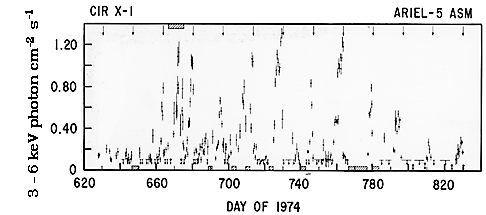Cir X-1 light curveThis light curve of the bursting low mass X-ray binary, Circinus X-1 is from the Ariel 5 All-Sky Monitor. Bursting from this source often exceeds the Eddington limit. The Eddington limit is defined as the luminosity where the radiation pressure (outward) is sufficient to overcome the gravitational potential of the compact object, and thereby stop the accretion of matter onto it. This limit can be exceeded in highly eccentric systems where the neutron star passes very close to the companion. Here, the release of radiation is so powerful over a short period of time at periastron that its pressure expands and heats up the denser material near the companion star. In the light curve below, the arrows at the top indicate periastron, exactly the point where we would expect to see this increased emission. Cir X-1 is extremely variable on all timescales and has been in active and very low intesity states for hundreds of days at a time. In the 1970s (during which the below light curve was taken), the source decreased abruptly (in less than 100 minutes) from high to low state every 16.6 days. It stayed low for 12 days, and then brightened for 4 days. A burst which is not associated with a periastron passage is visible around day 665 (corresponding to the hatched area between the third and fourth arrows). This is most likely due to a transient in the nearby constellation Norma which flared at this time. All points represent 1/2-day averages. This figure is taken from Figure 1 of Kaluzienski, et al, 1976, ApJ Letter 208, L71.
IMAGES |
By Mission |
Stars |
HEASARC Home | Observatories | Archive | Calibration | Software | Tools | Students/Teachers/Public Last modified: Thursday, 26-Jun-2003 13:48:45 EDT |


